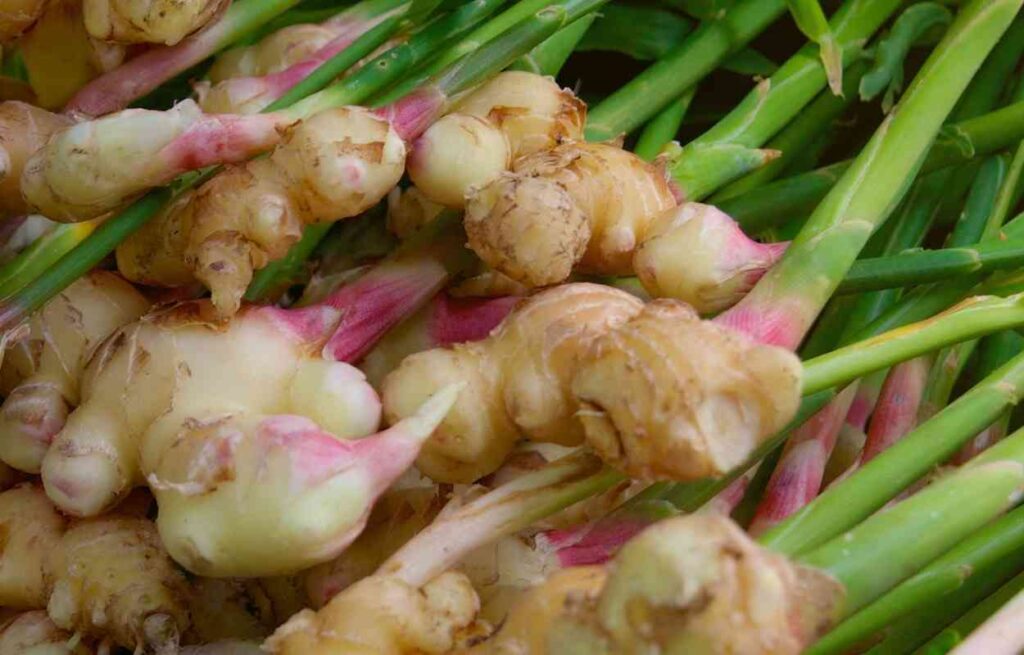Can You Use Ginger Leaves in Cooking?
Ginger, with its distinct aroma and spicy flavor, is a staple in many kitchens around the world. But can you use ginger leaves in cooking?
Yes, ginger leaves can be used in cooking. These edible leaves offer a milder flavor compared to the ginger rhizome. They can be finely chopped and used as a garnish, added to salads, steeped for tea, sautéed, boiled, steamed, stir-fried, added to soups and stews, pickled, or cooked with soy sauce.
Ginger leaves provide a valuable addition to the culinary repertoire, bringing unique aroma and taste to various dishes. Packed with a plethora of health benefits and bursting with flavor, ginger leaves are a hidden gem waiting to be explored.

Can You Use Ginger Leaves in Cooking?
When it comes to culinary uses, ginger leaves can be a versatile addition to your kitchen. While the root is commonly used for its strong flavor and medicinal properties, the leaves offer a milder taste that can enhance the flavor of your dishes without overpowering them.
Stir-Fries, Soups, Curries, and Stews
Ginger leaves can be chopped finely and added to stir-fries, soups, curries, and stews to infuse a mild gingery flavor into the dishes. They provide freshness and aroma without overpowering the other ingredients.
Salads
Chopped or torn ginger leaves can be added to salads for an extra zing. They pair well with citrus fruits, cucumbers, and herbs like mint and cilantro, adding a unique twist to your salad mix.
Ginger Leaf Pesto
Create a unique twist on classic basil pesto by blending ginger leaves with garlic, nuts, olive oil, and a touch of lemon juice. The resulting ginger leaf pesto can be used as a spread or a dip, adding vibrant and aromatic flavors to your dishes.
Teas and Infusions
Steeping ginger leaves in hot water can create a soothing and aromatic tea. You can enjoy it on its own or combine ginger leaves with other herbs like lemongrass and mint for a more complex flavor profile. Ginger leaf teas are perfect for relaxing after a long day.
Health Benefits of Ginger Leaves
In addition to their culinary uses, ginger leaves also offer a wide range of health benefits.
Anti-Inflammatory and Antioxidant Properties
Ginger leaves contain gingerol, a compound known for its anti-inflammatory and antioxidant properties. These properties can help reduce inflammation in the body and protect against oxidative stress, which is associated with various chronic diseases.
Digestive Benefits
Ginger leaves are renowned for their digestive benefits. They can alleviate symptoms of indigestion, bloating, and nausea. Adding ginger leaves to meals or drinking ginger leaf tea can promote healthy digestion and provide relief for an upset stomach.
Pain Relief and Muscle Soreness
For centuries, ginger leaves have been used in traditional medicine to relieve pain and reduce muscle soreness. Applied topically as a poultice or added to bathwater, ginger leaves offer a soothing and relaxing experience. Their anti-inflammatory properties can help alleviate pain and inflammation, making them a natural remedy for conditions like arthritis and muscle strains.
How to Use Ginger Leaves in Cooking?
Using ginger leaves in your cooking is simple and straightforward. Here are a few tips to help you get started:
Step 1: Harvesting Ginger Leaves
If you have a ginger plant at home, you can harvest the leaves as needed. Simply cut off the leaves at the stem, making sure to leave enough foliage for the plant to continue growing. It’s best to harvest the leaves when they are young and tender for the best flavor.
Step 2: Preparing Ginger Leaves
Before using ginger leaves, make sure to wash them thoroughly under cold water to remove any dirt or debris. Pat them dry with a clean towel or use a salad spinner to remove excess moisture.
Step 3: Chopping or Tearing
Depending on your recipe, you can either chop the ginger leaves finely or tear them into smaller pieces. Chopping the leaves will release more flavor while tearing them will create a more rustic look.
Step 4: Adding to Recipes
Ginger leaves can be added to a wide range of recipes, from soups and stir-fries to salads and marinades. The leaves can be added at the beginning of cooking for a more subtle flavor or toward the end for a stronger taste.
Step 5: Experimenting with Combinations
Don’t be afraid to experiment with different flavor combinations when using ginger leaves. They pair well with a variety of ingredients, including garlic, chili, soy sauce, and coconut milk. Let your creativity guide you and don’t be afraid to try new things.
Popular Recipes Using Ginger Leaves
Now that you know how to use ginger leaves in your cooking, let’s explore some popular recipes that feature this versatile ingredient:
- Ginger Leaf Stir-Fry: Heat some oil in a pan and add chopped ginger leaves, garlic, and your choice of vegetables or protein. Stir-fry until the leaves are wilted and the ingredients are cooked through. Season with soy sauce, salt, and pepper to taste.
- Ginger Leaf Salad: Combine torn ginger leaves, sliced cucumbers, cherry tomatoes, and a dressing made with lime juice, olive oil, honey, and a pinch of salt. Toss everything together and garnish with chopped mint leaves for a refreshing and vibrant salad.
- Ginger Leaf Tea: Steep a handful of ginger leaves in hot water for 5-10 minutes. Strain the leaves and sweeten them with honey if desired. Enjoy the soothing and aromatic tea as a calming beverage or as a remedy for digestive discomfort.
Can You Cook with Ginger Leaves?
Ginger leaves are suitable for cooking and can be utilized in various culinary preparations. With a milder flavor compared to the ginger rhizome.
These edible leaves can be finely chopped and used as a fragrant garnish, sparingly added to salads, steeped in boiling water for tea, sautéed alongside onions and garlic, boiled or steamed, stir-fried, incorporated into soups and stews, pickled in vinegar, or cooked with soy sauce.
To preserve ginger leaves, they can be frozen in ice cubes or dehydrated for future use in stews, soups, or tea. Growing ginger plants allows for the accessibility of fresh ginger leaves while ensuring pesticide-free produce.
Hence, although often overlooked, ginger leaves can be a valuable addition to one’s culinary repertoire.
Can You Cook with Ginger Leafs?
These edible ginger leaves offer a milder flavor compared to the ginger rhizome and can be utilized in various culinary applications.
They can be finely chopped and used as a fragrant garnish, added sparingly to salads, steeped in boiling water for tea, sautéed with onions and garlic, boiled or steamed, stir-fried, incorporated into soups and stews, pickled in vinegar, or cooked with soy sauce.
Despite being often overlooked, ginger leaves can serve as a valuable addition to one’s culinary repertoire.
Can You Cook with Ginger Leaves in Rice Cooker?
While ginger leaves can add a delightful flavor to various dishes, including rice, it is not recommended to directly cook them in a rice cooker. Ginger leaves are typically tough and fibrous, making them unsuitable for cooking in a rice cooker.
However, you can still infuse the flavor of ginger leaves into rice by wrapping a few leaves in cheesecloth or a tea infuser and placing it in the rice cooker while the rice is cooking.
This allows the aromatic essence of the leaves to permeate the rice without compromising its texture. It is important to remove the ginger leaves after cooking to avoid any unwanted fibrous residue.
Where to Find and Buy Ginger Leaves
Finding ginger leaves can be a bit challenging, as they are not as commonly available as ginger root. However, there are a few places where you can look for ginger leaves:
- Asian Grocery Stores: Asian grocery stores often carry a wide variety of fresh herbs and produce, including ginger leaves. Check the produce section or ask the store staff for assistance.
- Farmers Markets: Local farmer’s markets are a great place to find fresh and seasonal produce, including ginger leaves. Visit your nearest farmers market and inquire if any vendors have ginger leaves available.
- Online Retailers: If you’re unable to find ginger leaves locally, you can also explore online retailers that specialize in herbs and spices. They may offer dried ginger leaves or even live ginger plants that you can grow at home.
Tips for Storing Ginger Leaves
To keep ginger leaves fresh for longer, follow these storage tips:
- Refrigeration: Place the ginger leaves in a plastic bag or an airtight container and store them in the refrigerator. They can stay fresh for up to a week when properly stored.
- Freezing: If you have an abundance of ginger leaves, you can freeze them for later use. Blanch the leaves in boiling water for a few seconds, then transfer them to an ice bath to cool. Pat them dry and place them in a freezer bag or container. Frozen ginger leaves can be stored for several months.
- Drying: If you prefer to use dried ginger leaves, you can air dry them by hanging them upside down in a well-ventilated area. Once they are completely dry, store them in an airtight container away from direct sunlight. Dried ginger leaves can be used in teas, spice blends, or added to soups and stews for a burst of flavor.
Conclusion
Ginger leaves are a gourmet gem just waiting to be discovered. Their distinct flavor, health advantages, and adaptability make them an essential element in any cooking.
Ginger leaves can offer a touch of freshness and aroma to everything from stir-fries and salads to teas and pestos. Whether you grow your own ginger plant or buy the leaves at a local market, cooking with ginger leaves will be a wonderful and gratifying experience.
So, why not give it a try? Unlock the potential of ginger leaves and explore a whole new realm of flavors and possibilities in your cooking.
Contents
- Can You Use Ginger Leaves in Cooking?
- Health Benefits of Ginger Leaves
- How to Use Ginger Leaves in Cooking?
- Popular Recipes Using Ginger Leaves
- Can You Cook with Ginger Leaves?
- Can You Cook with Ginger Leafs?
- Can You Cook with Ginger Leaves in Rice Cooker?
- Where to Find and Buy Ginger Leaves
- Tips for Storing Ginger Leaves
- Conclusion
